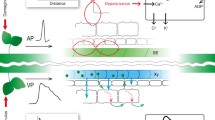Abstract.
Despite the availability of many mutants for signal transduction, Arabidopsis thaliana guard cells have so far not been used in electrophysiological research. Problems with the isolation of epidermal strips and the small size of A. thaliana guard cells were often prohibiting. In the present study these difficulties were overcome and guard cells were impaled with double-barreled microelectrodes. Membrane-potential recordings were often stable for over half an hour and voltage-clamp measurements could be conducted. The guard cells were found to exhibit two states. The majority of the guard cells had depolarized membrane potentials, which were largely dependent on external K+ concentrations. Other cells displayed spontaneous transitions to a more hyperpolarized state, at which the free-running membrane potential (Em) was not sensitive to the external K+ concentration. Two outward-rectifying conductances were identified in cells in the depolarized state. A slow outward-rectifying channel (s-ORC) had properties resembling the K+-selective ORC of Vicia faba guard cells (Blatt, 1988, J Membr Biol 102: 235–246). The activation and inactivation times and the activation potential, all depended on the reversal potential (Erev) of the s-ORC conductance. The s-ORC was blocked by Ba2+ (K1/2 = 0.3–1.3mM) and verapamil (K1/2 = 15–20 μM). A second rapid outward-rectifying conductance (r-ORC) activated instantaneously upon stepping the voltage to positive values and was stimulated by Ba2+. Inward-rectifying channels (IRC) were only observed in cells in the hyperpolarized state. The activation time and activation potential of this channel were not sensitive to the external K+ concentration. The slow activation of the IRC (t1/2 ≈ 0.5 s) and its negative activation potential (Vthreshold = −155 mV) resemble the values found for the KAT1 channel expressed in Saccharomyces cerevisiae (Bertl et al., 1995, Proc Natl Acad Sci USA 92: 2701–2705). The results indicate that A. thaliana guard cells provide an excellent system for the study of signal transduction processes.
Similar content being viewed by others
Author information
Authors and Affiliations
Additional information
Received: 28 March 1996 / Accepted: 11 November 1996
Rights and permissions
About this article
Cite this article
Roelfsema, M., Prins, H. Ion channels in guard cells of Arabidopsis thaliana (L.) Heynh.. Planta 202, 18–27 (1997). https://doi.org/10.1007/s004250050098
Issue Date:
DOI: https://doi.org/10.1007/s004250050098




